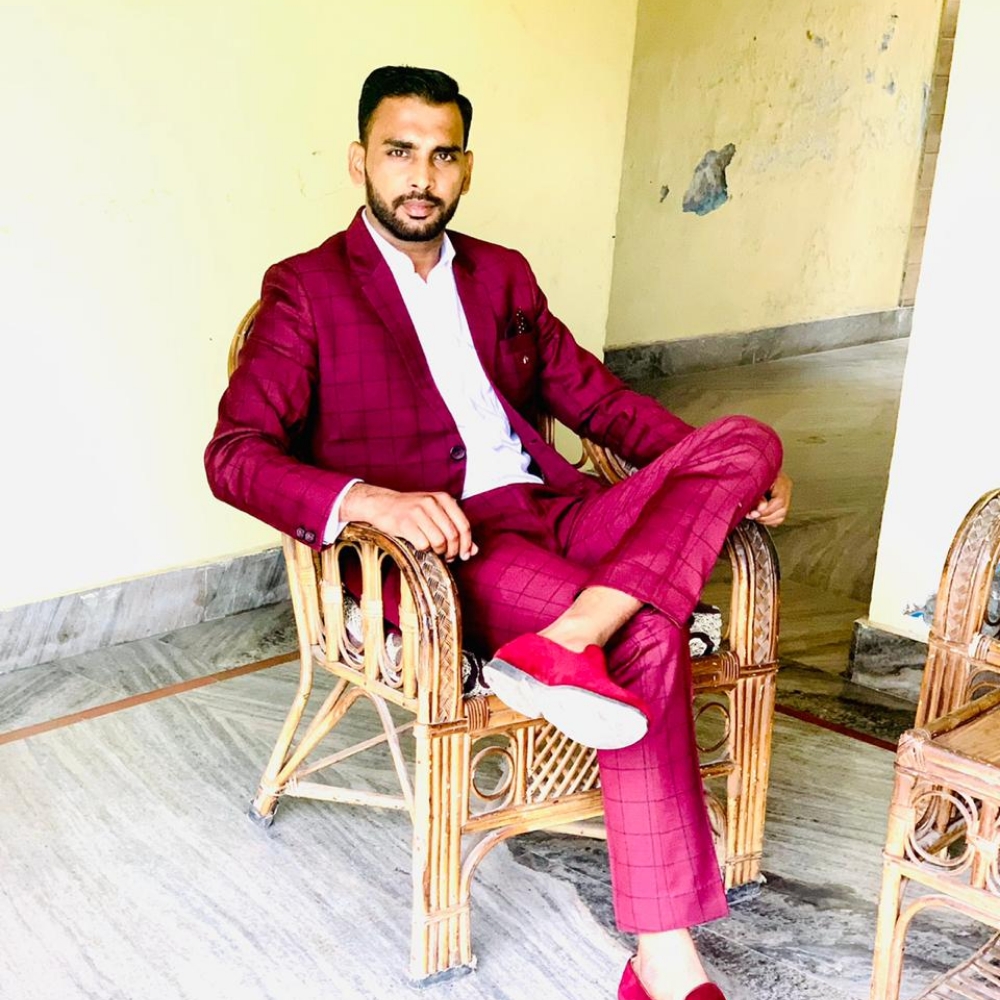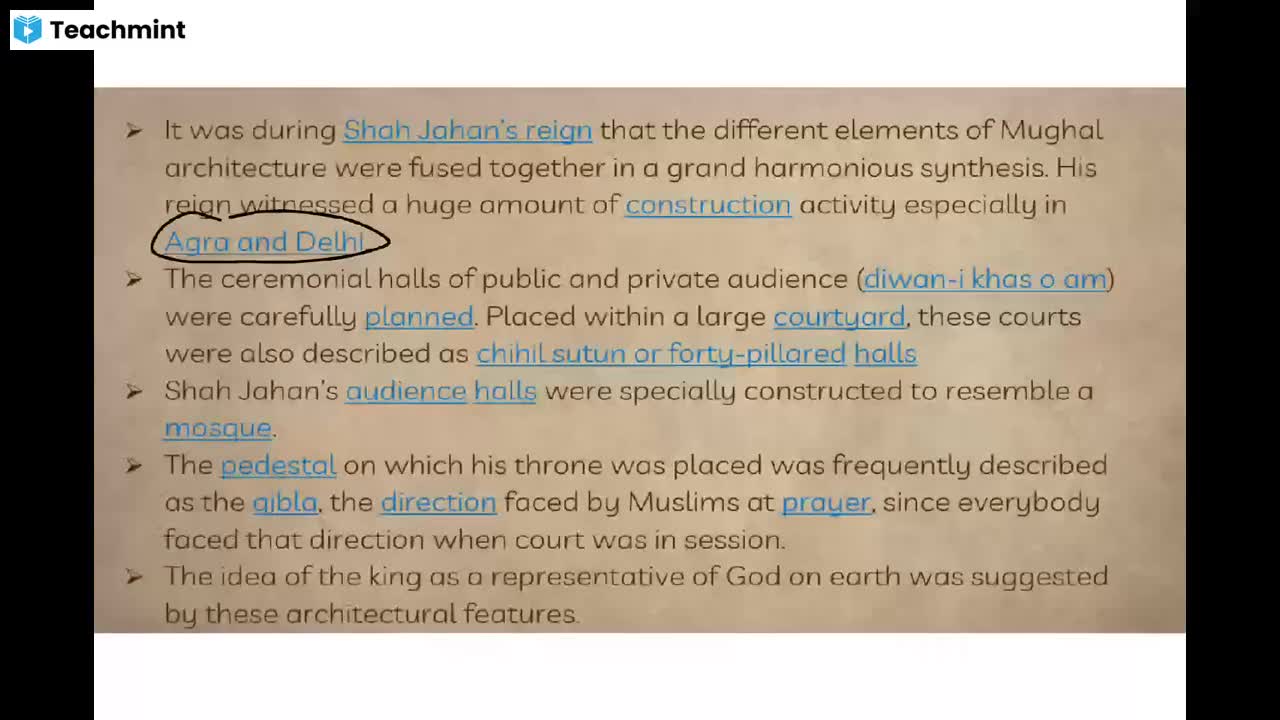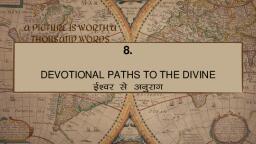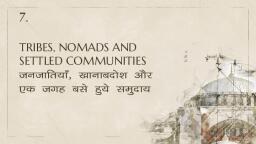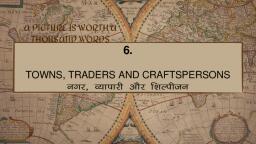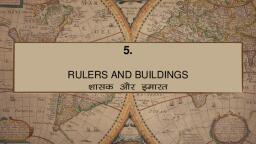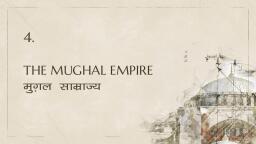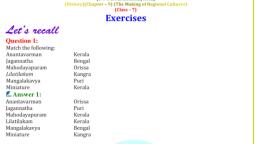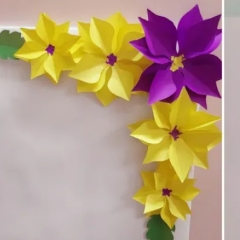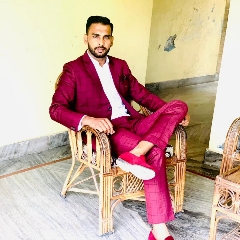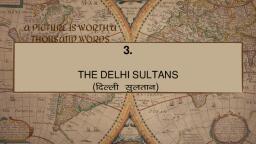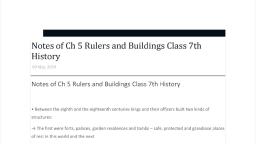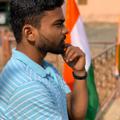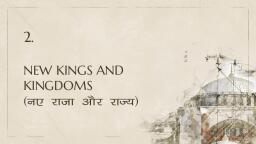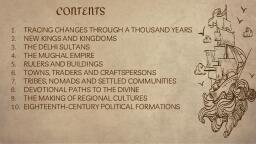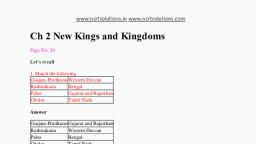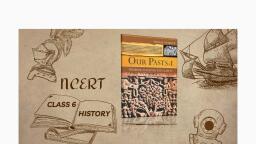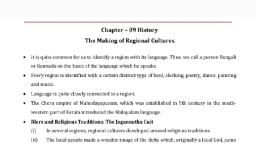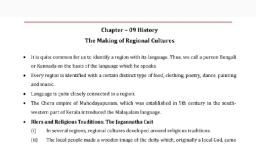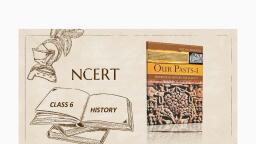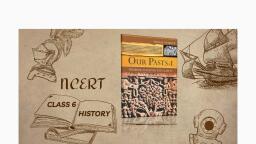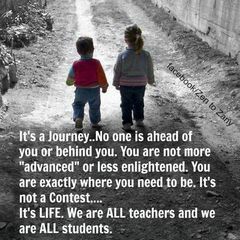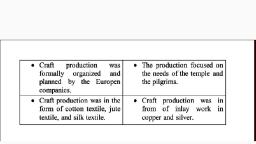Page 2 :
OVERVIEW, 1. THE CHERAS AND THE DEVELOPMENT OF MALAYALAM, 2. RULERS AND RELIGIOUS TRADITIONS:, 3., 4., 5., 6., , 4, , THE JAGANNATHA CULT, THE RAJPUTS AND TRADITIONS OF HEROISM, BEYOND REGIONAL FRONTIERS: THE STORY OF KATHAK, A CLOSER LOOK: BENGAL, PIRS AND TEMPLES
Page 3 :
⬗ One of the commonest ways of describing people is in terms of the language, they speak., ⬗ We also tend to associate each region with distinctive kinds of food, clothes,, poetry, dance, music and painting., , ⬗ What we understand as regional cultures today are often the product of, , complex processes of intermixing of local traditions with ideas from other, parts of the subcontinent., ⬗ Some traditions appear specific to some regions, others seem to be similar, across regions, and yet others derive from older practices in a particular area,, but take a new form in other regions., , 5
Page 4 :
The Cheras and the Development of, Malayalam, psj vkSj ey;kye Hkk"kk dk fodkl, ⬗ The Chera kingdom of Mahodayapuram was established in, the ninth century in the south-western part of the peninsula,, part of present-day Kerala, ⬗ The rulers introduced the Malayalam language and script in, their inscriptions., ⬗ In fact, this is one of the earliest examples of the use of a, regional language in official records in the subcontinent., 6
Page 5 :
⬗ The Cheras also drew upon Sanskritic traditions., ⬗ The temple theatre of Kerala, which is traced to this period,, borrowed stories from the Sanskrit epics., ⬗ The first literary works in Malayalam, dated to about the, twelfth century, are directly indebted to Sanskrit., , ⬗ Interestingly enough, a fourteenth-century text, the, Lilatilakam, dealing with grammar and poetics, was, composed in Manipravalam – literally, “diamonds and, corals” referring to the two languages, Sanskrit and the, regional language, 7
Page 6 :
⬗ An early Kerala inscription,, , composed in Malayalam., , 8
Page 7 :
9
Page 9 :
✓ To date, the local tribal people make the wooden image of, the deity, which suggests that the deity was originally a local, god, who was later identified with Vishnu, , ✓ The icons of Balabhadra,, Subhadra and Jagannatha,, palmleaf manuscript, Orissa.
Page 11 :
⬗ In the twelfth century, one of the most important rulers of the Ganga, , dynasty, Anantavarman, decided to erect a temple for Purushottama, Jagannatha at Puri., ⬗ Subsequently, in 1230, king Anangabhima III dedicated his kingdom to, the deity and proclaimed himself as the “deputy” of the god., , ⬗ As the temple gained in importance as a centre of pilgrimage, its authority, in social and political matters also increased., ⬗ All those who conquered Orissa, such as the Mughals, the Marathas and, the English East India Company, attempted to gain control over the, temple., ⬗ They felt that this would make their rule acceptable to the local people., 13
Page 12 :
The Rajputs and Traditions of Heroism, jktiwr vkSj 'kwjohjrk dh ijaijk,¡, ➢In the nineteenth century, the region that constitutes most of present-day, Rajasthan, was called Rajputana by the British., ➢While this may suggest that this was an area that was inhabited only or mainly, by Rajputs, this is only partly true. There were (and are) several groups who, identify themselves as Rajputs in many areas of northern and central India. And, of course, there are several peoples other than Rajputs who live in Rajasthan., ➢However, the Rajputs are often recognised as contributing to the distinctive, culture of Rajasthan., 14
Page 13 :
➢ These cultural traditions were closely linked with the ideals and aspirations of, rulers. From about the eighth century, most of the present-day state of, Rajasthan was ruled by various Rajput families., ➢ Prithviraj was one such ruler., ➢These rulers cherished the ideal of the hero who fought valiantly, often, choosing death on the battlefield rather than face defeat., ➢, ➢, 15, , Stories about Rajput heroes were recorded in poems and songs, which were, recited by specially trained minstrels., These preserved the memories of heroes and were expected to inspire others, to follow their example.
Page 14 :
➢, , Ordinary people were also attracted by these stories – which, often depicted dramatic situations, and a range of strong, emotions – loyalty, friendship, love, valour, anger, etc, , Women are also depicted as following their heroic husbands in, both life and death – there are stories about the practice of sati or, the immolation of widows on the funeral pyre of their husbands., ➢ So those who followed the heroic ideal often had to pay for it, with their lives, ➢, , 16
Page 15 :
17
Page 16 :
Beyond Regional Frontiers:, The Story of Kathak, {ks=h; lhekarksa ls ijs µ dRFkd u`R; dh dgkuh, The term kathak is derived from katha, a word used in Sanskrit, and other languages for story., ➢ The kathaks were originally a caste of story-tellers in temples of, north India, who embellished their performances with gestures, and songs., ➢, , 18
Page 17 :
➢ Kathak began evolving into a distinct mode of dance in the fifteenth and, sixteenth centuries with the spread of the bhakti movement., ➢ The legends of Radha-Krishna were enacted in folk plays called rasa lila,, which combined folk dance with the basic gestures of the kathak story-tellers., ➢ Under the Mughal emperors and their nobles, Kathak was performed in the, court, where it acquired its present features and developed into a form of, dance with a distinctive style., ➢ Subsequently, it developed in two traditions or gharanas:, one in the courts of Rajasthan (Jaipur) and, the other in Lucknow., 19
Page 18 :
❑ Under the patronage of Wajid Ali Shah, the last Nawab of Awadh, it grew into a, major art form., ❑ By the third quarter of the nineteenth century it was firmly entrenched as a dance, form not only in these two regions, but in the adjoining areas of present-day Punjab,, Haryana, Jammu and Kashmir, Bihar and Madhya Pradesh., ❑ Emphasis was laid on intricate and rapid footwork, elaborate costumes, as well as on, the enactment of stories, ❑ Kathak, like several other cultural practices, was viewed with disfavour by most, British administrators in the nineteenth and twentieth centuries., ❑ However, it survived and continued to be performed by courtesans, and was, recognised as one of six “classical” forms of dance in the country after, independence., , 20
Page 20 :
22
Page 21 :
“Classical” dances ( 'kkL=kh; u`R; ), ➢ The question of defining any art form as “classical” is often quite complicated, ➢ It is worth remembering that many dance forms that are classified as “folk”, also share several of the characteristics considered typical of “classical”, forms. So, while the use of the term “classical” may suggest that these forms, are superior, this need not always be literally true, , ➢, , 23, , ➢, ➢, ➢, ➢, , Other dance forms that are recognised as classical at present are:, Bharatanatyam (Tamil Nadu), Kathakali (Kerala), Odissi (Odisha), Kuchipudi (Andhra Pradesh), Manipuri (Manipur)
Page 22 :
24
Page 24 :
➢, , The Mughal emperors Akbar, Jahangir and Shah Jahan, patronised highly skilled painters who primarily illustrated, manuscripts containing historical accounts and poetry., , These were generally painted in brilliant colours and portrayed, court scenes, scenes of battle or hunting, and other aspects of, social life., ➢ They were often exchanged as gifts and were viewed only by an, exclusive few – the emperor and his close associates, ➢, , 26
Page 25 :
Akbar resting, during a hunt,, Mughal miniature., , 27
Page 26 :
➢, , With the decline of the Mughal Empire, many painters moved out to the, courts of the emerging regional states., , ➢, , As a result Mughal artistic tastes influenced the regional courts of the, Deccan and the Rajput courts of Rajasthan., At the same time, they retained and developed their distinctive, characteristics. Portraits of rulers and court scenes came to be painted,, following the Mughal example., Besides, themes from mythology and poetry were depicted at centres such as, Mewar, Jodhpur, Bundi, Kota and Kishangarh., , ➢, , ➢, , 28
Page 28 :
➢, , Another region that attracted miniature paintings was the Himalayan, foothills around the modern-day state of Himachal Pradesh., , ➢, , By the late seventeenth century this region had developed a bold and intense, style of miniature painting called Basohli., The most popular text to be painted here was Bhanudatta’s Rasamanjari., Nadir Shah’s invasion and the conquest of Delhi in 1739 resulted in the, migration of Mughal artists to the hills to escape the uncertainties of the, plains., Here they found ready patrons which led to the founding of the Kangra, school of painting, , ➢, ➢, , ➢, , 30
Page 29 :
➢, ➢, ➢, , ➢, , 31, , By the mideighteenth century the Kangra artists developed a style which, breathed a new spirit into miniature painting., The source of inspiration was the Vaishnavite traditions., Soft colours including cool blues and greens, and a lyrical treatment of, themes distinguished Kangra painting., Ordinary women and men painted as well – on pots, walls, floors, cloth –, works of art that have occasionally survived, unlike the miniatures that were, carefully preserved in palaces for centuries.
Page 31 :
A Closer Look: Bengal, The Growth of a Regional Language, ,d {ks=h; Hkk"kk dk fodkl, ➢, , ➢, , 33, , While Bengali is now recognised as a language derived from Sanskrit, early, Sanskrit texts (mid-first millennium BCE) suggest that the people of Bengal, did not speak Sanskritic languages., From the fourth-third centuries BCE, commercial ties began to develop, between Bengal and Magadha (south Bihar), which may have led to the, growing influence of Sanskrit
Page 33 :
➢, ➢, , ➢, , In the seventh century the Chinese traveller Xuan Zang observed that, languages related to Sanskrit were in use all over Bengal., , ➢, , From the eighth century, Bengal became the centre of a regional kingdom, under the Palas ., Between the fourteenth and sixteenth centuries, Bengal was ruled by Sultans, who were independent of the rulers in Delhi ., , ➢, 35, , During the fourth century the Gupta rulers established political control, over north Bengal and began to settle Brahmanas in this area., Thus, the linguistic and cultural influence from the mid-Ganga valley, became stronger.
Page 34 :
➢, ➢, , ➢, , ➢, , 36, , In 1586, when Akbar conquered Bengal, it formed the nucleus of the Bengal, suba., While Persian was the language of administration, Bengali developed as a, regional language., By the fifteenth century the Bengali group of dialects came to be united by a, common literary language based on the spoken language of the western part, of the region, now known as West Bengal. Thus, although Bengali is derived, from Sanskrit, it passed through several stages of evolution., Also, a wide range of non-Sanskrit words, derived from a variety of sources, including tribal languages, Persian, and European languages, have become, part of modern Bengali.
Page 35 :
➢, , Early Bengali literature may be divided into two categories –, one indebted to Sanskrit and, the other independent of it., , ➢, , The first includes translations of the Sanskrit epics, the Mangalakavyas, (literally auspicious poems, dealing with local deities) and bhakti literature, such as the biographies of Chaitanyadeva, the leader of the Vaishnava bhakti, movement, The second includes Nath literature such as the songs of Maynamati and, Gopichandra, stories concerning the worship of Dharma Thakur, and fairy, tales, folk tales and ballads., , ➢, , 37
Page 36 :
➢, , The texts belonging to the first category are easier to date, as several, manuscripts have been found indicating that they were composed, between the late fifteenth and mid-eighteenth centuries., , ➢, , Those belonging to the second category circulated orally and cannot be, precisely dated., They were particularly popular in eastern Bengal, where the influence, of Brahmanas was relatively weak., , ➢, , 38
Page 37 :
Maynamati, Gopichandra and, Dharma Thakur, ➢, ➢, , ➢, , 39, , The Naths were ascetics who engaged in a variety of yogic, practices., This particular song, which was often enacted, described how, Maynamati, a queen, encouraged her son Gopichandra to adopt, the path of asceticism in the face of a variety of obstacles., Dharma Thakur is a popular regional deity, often worshipped in, the form of a stone or a piece of wood.
Page 39 :
Pirs and Temples, ➢, , ➢, , ➢, , 41, , From the sixteenth century, people began to migrate in large numbers from, the less fertile western Bengal to the forested and marshy areas of southeastern Bengal., As they moved eastwards, they cleared forests and brought the land under, rice cultivation., Gradually, local communities of fisherfolk and shifting cultivators, often, tribals, merged with the new communities of peasants
Page 40 :
➢, , This coincided with the establishment of Mughal control over Bengal with, their capital in the heart of the eastern delta at Dhaka., , ➢, , Officials and functionaries received land and often set up mosques that, served as centres for religious transformation in these areas., The early settlers sought some order and assurance in the unstable, conditions of the new settlements., These were provided by community leaders, who also functioned as teachers, and adjudicators and were sometimes ascribed with supernatural powers., , ➢, ➢, , ➢, , 42, , People referred to them with affection and respect as pirs
Page 41 :
43, , ➢, , Pirs included saints or Sufis and other religious personalities, daring, colonisers and deified soldiers, various Hindu and Buddhist deities and even, animistic spirits., , ➢, , Animism ( thookn), , ➢, , Attribution of living soul to plants, inanimate objects, and natural, phenomena., , ➢, , The cult of pirs became very popular and their shrines can be found, everywhere in Bengal.
Page 42 :
➢, ➢, , ➢, , ➢, ➢, 44, , Bengal also witnessed a temple-building spree from the late fifteenth century,, which culminated in the nineteenth century., Temples and other religious structures were often built by individuals or groups, who were becoming powerful – to both, demonstrate their power and, proclaim their piety, Many of the modest brick and terracotta temples in Bengal were built with the, support of several “low” social groups, such as the Kolu (oil pressers) and the, Kansari (bell metal workers)., The coming of the European trading companies created new economic, opportunities; many families belonging to these social groups availed of these., As their social and economic position improved, they proclaimed their status, through the construction of temples
Page 43 :
➢, , A double-roofed, thatched hut, , 45, , A four-roofed temple, with a tower
Page 45 :
➢, ➢, , ➢, ➢, , ➢, , 47, , When local deities, once worshipped in thatched huts in villages, gained the, recognition of the Brahmanas, their images began to be housed in temples., The temples began to copy the double-roofed (dochala) or four-roofed, (chauchala) structure of the thatched huts. (Remember the “Bangla dome” in, Chapter 5?), This led to the evolution of the typical Bengali style in temple architecture., In the comparatively more complex four-roofed structure, four triangular roofs, placed on the four walls move up to converge on a curved line or a point., Temples were usually built on a square platform., The interior was relatively plain, but the outer walls of many temples were, decorated with paintings, ornamental tiles or terracotta tablets.
Page 46 :
➢, , In some temples, particularly in Vishnupur in the Bankura district of West, Bengal, such decorations reached a high degree of excellence., , FISH AS FOOD, ⬗ Bengal is a riverine plain which produces plenty of rice and fish., Understandably, these two items figure prominently in the menu of even poor, Bengalis., ⬗ Fishing has always been an important occupation and Bengali literature contains, several references to fish., ⬗ Terracotta plaques on the walls of temples and viharas (Buddhist monasteries), depict scenes of fish being dressed and taken to the market in baskets., 48
Page 47 :
⬗ Brahmanas were not allowed to eat nonvegetarian food, but the popularity of, fish in the local diet made the Brahmanical authorities relax this prohibition, for the Bengal Brahmanas., ⬗ The Brihaddharma Purana, a thirteenth-century Sanskrit text from Bengal,, permitted the local Brahmanas to, eat certain varieties of fish, , Fish being dressed for domestic, consumption, terracotta plaque from, the Vishalakshi temple, Arambagh., 49
Page 48 :
Emergence of nation-states in Europe, ;wjksi esa jk"Vª&jkT;ksa dk mn;, ➢, , ➢, , ➢, , 50, , Till the eighteenth century, people in Europe saw themselves as subjects of, an empire, such as the Austro-Hungarian empire, or members of a church,, such as the Greek Orthodox church., But, from the late eighteenth century, people also began to identify, themselves as members of a community that spoke a common language,, such as French or German., , By the early nineteenth century, in Rumania school textbooks began to be, written in Rumanian rather than in Greek, and in Hungary Hugarian was, adopted as the official language instead of Latin.
Page 49 :
Emergence of nation-states in Europe, ;wjksi esa jk"Vª&jkT;ksa dk mn;, Other similar developments created the consciousness among, the people that each linguistic community was a separate, nation., ➢ This feeling was strengthened by the movements for Italian and, German unification in the late nineteenth century., ➢, , 51
Page 50 :
52
Page 52 :
Thanks!, , 54
